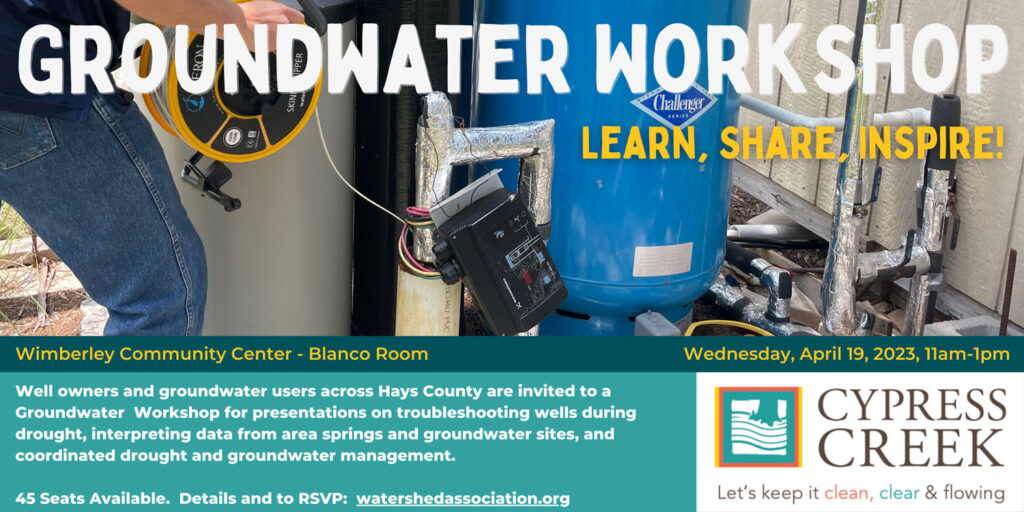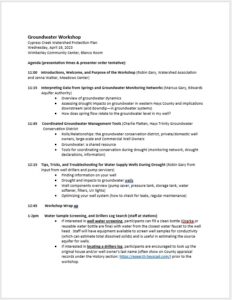
Western Hays County is a groundwater-dependent area. All residents and businesses rely on groundwater or rainwater as their drinking water supply. The springs that provide baseflow to Cypress Creek and the Blanco River come from the same water supply aquifer–the Middle Trinity. With drought and increases in population, it is important to raise awareness about monitoring data, conservation efforts, and ways to optimize well systems to avoid unnecessary water use, like leaks.
A Groundwater Workshop held at the Wimberley Community Center on Wednesday, April 19 was organized as part of the Cypress Creek Watershed Protection Plan. Approximately 50 participants joined in person or through Zoom. The meeting was recorded (link coming soon). Presentations included information on troubleshooting tips and tricks for water supply wells during drought, interpreting data from area springs and groundwater monitoring sites, and drought and groundwater management. Speakers included Robin Gary of the Watershed Association, Charlie Flatten of the Hays Trinity Groundwater Conservation District, and Marcus Gary of the Edwards Aquifer Authority.
Workshop Recap:
About the Cypress Creek Project: Jenna Walker, Meadows Center for Water and the Environment; Robin Gary and David Baker, Watershed Association
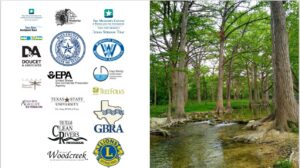
Jacob’s Well stopped flowing for the first time in 2000, causing Cypress Creek to be listed by TCEQ as an impaired stream because of poor water quality and aquatic habitat. Moved to better protect springflow a group of stakeholders developed the Cypress Creek Watershed Protection Plan, which was approved by the Environmental Protection Agency in 2014 and work to implement the Plan was funded by TCEQ shortly thereafter. The Meadows Center for Water and the Environment has played a key role coordinating with local, regional and state partners. Workshops, data collection, policy work, and best management practices projects have led to many successes over the three cycles of funding over 8 years for implementation activities. The funding will expire in August of 2023, and the community will need to decide how to move forward and support the critical work that balances land stewardship, water protection, and responsible development across many scales.
Interpreting Data from Springs and Groundwater Monitoring Networks: Marcus Gary, Ph.D., Edwards Aquifer Authority
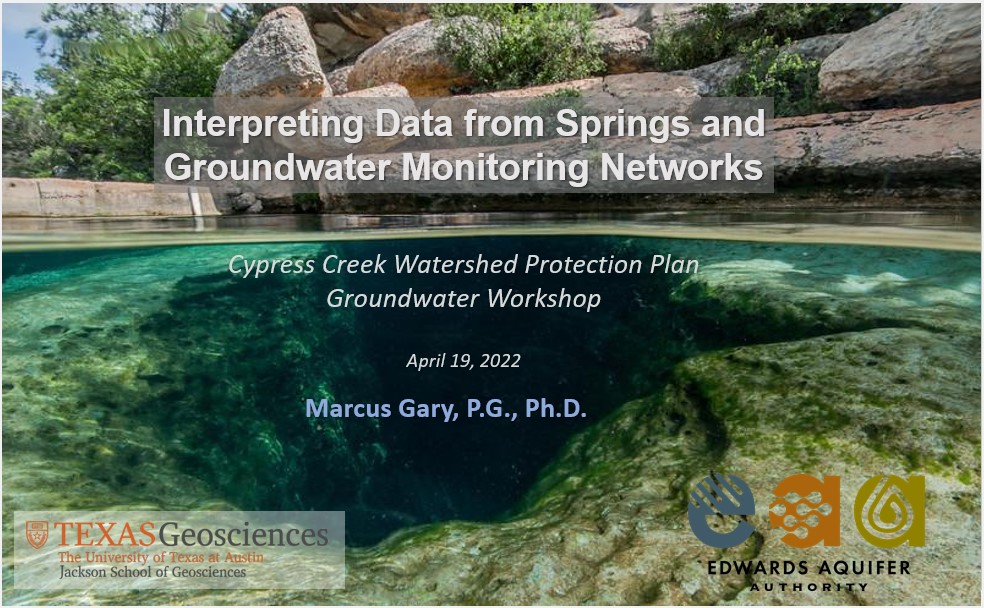
The majority of water supply wells are completed in the Middle Trinity Aquifer; this is also the same water source for the springs providing baseflow in the Blanco River and Cypress Creek. Cave divers have mapped Jacob’s Well Cave, and based on their survey we know that the majority of the cave passage is within the Cow Creek Limestone of the Middle Trinity Aquifer. Pleasant Valley Spring in the Blanco River was documented in 2013 through a gain/loss study. Pleasant Valley Spring, Park Springs, and Miller Springs provide the baseflow for the western Hays County section of the Blanco River. Spring flow from these Middle Trinity springs is correlated to the amount of groundwater in storage in the Middle Trinity Aquifer. Knowing how your well is completed and what part of the aquifer your well is completed in is important to track water level changes in your well. Generally, when spring flow is low, groundwater storage is low, too. What happens in the Trinity Aquifer systems influences the wells, springs, creeks, and rivers… and the wells, springs, creeks, and rivers downstream, too. The Trinity Aquifer is updip (groundwater speak for upstream) from the Edwards Aquifer; and the two are tightly connected.
Coordinated Groundwater Management Tools: Charlie Flatten, Hays Trinity Groundwater Conservation District
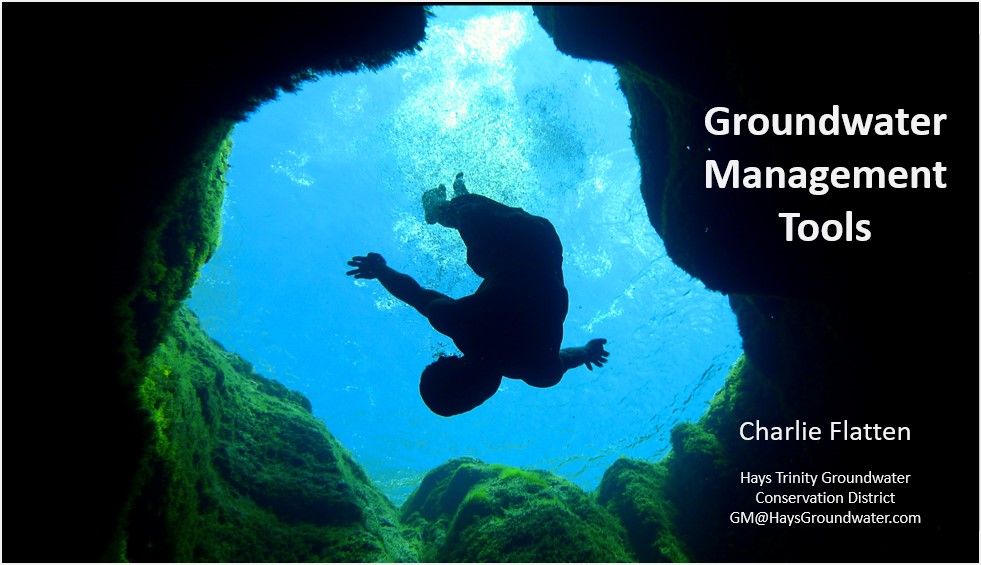
Groundwater Conservation Districts (GCDs) are created by the Texas Legislature and are the preferred way to manage groundwater. Chapter 36 of the Texas Administrative Code plus the GCDs enabling legislation set the groundwater management tools and funding mechanisms for that GCD. The Hays Trinity Groundwater Conservation District has a limited set of tools to coordinate conservation and relies heavily on education, science, and drought declarations. Permitted wells (generally the larger capacity, commercial or public supply wells) have pumping targets and drought reductions associated with drought declarations. Exempt wells (small, domestic or agricultural wells) have to adhere to well construction standards and well owners are encouraged to register their wells, but there are no metering or drought reduction requirements; however, drought reductions are encouraged to help extend water supplies during drought. Groundwater is both a private property right and a shared resource. The District maintains an extensive monitoring network, and is currently in the most severe drought declaration available. The best tool is getting science and drought information out to residents through workshops, speaker series, and public meetings.
Tips, Tricks, and Troubleshooting for Water Supply Wells During Drought (Robin Gary from input from well drillers and pump servicers)
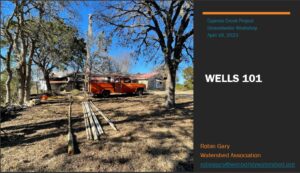
Learning more about your well makes it easier to better maintain it. Here’s generally how it works: When your pump kicks on, it pulls water from the well column and the surrounding rock formation (aquifer). If water moves slowly through the rocks, the water level in the well decline quickly and could even reach the level of the pump. Hydrogeologists talk about a ‘cone of depression’ which is the localized impact of pumping. For small-volume wells (like most residential wells), the effect of that pumping center is small. For large-volume wells, the area is more extensive. Groundwater may be a private property right, but it is a shared resource. Groundwater conservation districts often weigh the effects of a pumping center on surrounding wells through Aquifer Tests. In drought and in areas with heavy pumping, water levels regionally decline. Under those conditions, all wells have a lower starting point when they kick on. Lower water levels also mean less hydraulic head (or weight of water) which can cause water to move more slowly through the rock formations and can mean that the well takes longer to recover after the pump cycles.
Finding information on your well
In 2003 the Texas Department of Licensing and Regulation required well drillers to submit information online, and the Texas Water Development Board provides a useful interface to access that data. The Texas Commission on Environmental Quality has an interactive map that allow well owners to search scanned well records in a large pdf compiled by well grid (a reference well drillers use for location and well ID determination). Having the original well owner’s name and lot number can help identify the well record.
Professional well servicers suggest several general practices:
-
-
-
- Know where your breaker is.
- Know where your main cutoff valve is. Exercise your main cutoff valve 1-2 times a year.
- Have your well system checked every few years or if you’ve never had it checked before. Servicers will check for leaks, check pressure tank and pre-charge, and status of components.
- Pumps have a certain number of starts and stops. Well components (storage and
pressure tanks work to minimize those start/stops. (Info on well components)
-
-
Leaks and Leak Detection in Well Systems
Leaks are particularly problematic in well systems. Leaks are an unnecessary use of water and can cause undue wear and tear on the well pump, distribution system, and septic system. The EPA reports that 10% of all homes have a leak that wastes over 90 gallons a day. It’s worth monitoring your system to protect your investment in equipment and safeguard your water supply. Here are a few tips:
-
-
-
- Pressure Tank trick: Pay attention to your pressure tank (it’s loud), particularly while no water is being used. Pressure tanks can have a substantial volume that needs to be depleted before they kick on (44 gallon tank has a 16 gallon threshold; 85 gallon tank has a 28 gallon drawdown). If you have a big leak, you’ll hear the pressure tank kick on.
- Cutoff Valve trick: Close the main cutoff valve for a few minutes—don’t use any water. Slightly open the valve (so water flow is an audible hiss) and pay attention to how long it takes for the pressure to adjust. If it’s a significant amount of time, that means the water on the downstream side of the valve leaked out.
-
-
Reports, References, and Links:
-
-
- Evaluation for the Development of a Jacob’s Well Groundwater Management Zone in Hays County, Texas: Technical report documenting hydrogeology, wells, and water budget for the Jacob’s Well spring shed.
- Jacobs Well GMZ: Watershed Association website with history, background, and associated links.
- Hydrogeologic Atlas of the Hill Country Trinity Aquifer, Blanco, Hays, and Travis Counties, Central Texas: Technical report with geologic maps, cross sections, and well diagrams across the Hill Country
- Cypress Creek Watershed Protection Plan Project Summary: handout provided at the workshop describing the Cypress Creek Project partners, shared goals, and resources.
- Texas Living Waters: Water policy-oriented project with helpful legislative updates.
- Water Monitoring webpage: Watershed Association website with frequent hydro reports, links to local spring flow, streamflow, rainfall, and monitor well gauges.
-
Organizations’ Websites
-
-
- Cypress Creek Project website: Partners, project history, Watershed Protection Plan documents, examples of implemented BMPs
- Hays Trinity Groundwater Conservation District website
- Meadows Center for Water and the Environment website
- Edwards Aquifer Authority website
- Watershed Association website
-
